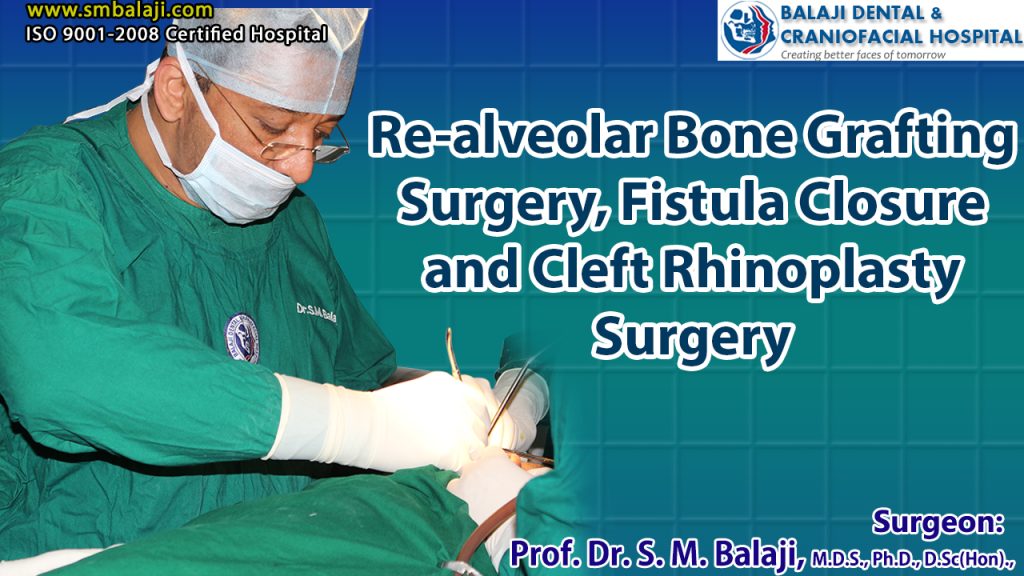Palatonasal and Bucconasal Fistula Closure Surgery
Initial Presentation: The patient presented at Balaji Dental and Craniofacial Hospital, Teynampet, Chennai with complaints of regurgitation of fluids from the oral cavity into the nose for a very long time. The patient stated that there were “two holes” in the bone on the right side of his upper jaw. Diagnostic Tests: Dr. SM. Balaji, Cranio-Maxillofacial Surgeon, examined the patient and ordered radiographic studies for diagnostic confirmation. He explained to the patient that the “two holes” were oronasal fistula that were connections between the oral cavity and the nasal cavity. He further explained how these were causing the patient’s regurgitation problems. He added that surgical correction was the only solution for this. The patient was in agreement with this plan of treatment and was scheduled for surgery. Surgical Procedure: Under general anesthesia, a palatal flap was raised for closure of the palatonasal fistula. The epithelialized portion of the fistulous tract was excised and tissue was mobilized around the fistula, which was then closed with the palatal flap. Following this, a mucogingival flap was raised for closure of the bucconasal fistula. The epithelialized portion of the fistulous tract was excised followed by mobilization of the tissue around the fistula. The flap was then utilized to close the fistula. The patient was then extubated and recovered uneventfully from general anesthesia.
Re-alveolar bone graft Surgery, Fistula Closure and Cleft Rhinoplasty Surgery

[et_pb_section fb_built=”1″ _builder_version=”3.22″][et_pb_row _builder_version=”3.25″ background_size=”initial” background_position=”top_left” background_repeat=”repeat”][et_pb_column type=”4_4″ _builder_version=”3.25″ custom_padding=”|||” custom_padding__hover=”|||”][et_pb_text _builder_version=”3.27.4″ background_size=”initial” background_position=”top_left” background_repeat=”repeat”]This young girl had been born with a left-sided cleft lip, alveolus, and palate. She had undergone repair of her cleft lip as an infant with an alveolar rib graft, but the graft hadn’t fused with the bone and had been a failure. She had developed an asymmetry of her nose because of this and a deficiency in the development of the cartilaginous part of her columella, which had lead to a collapsed left nostril. This had made her very quiet and withdrawn, isolating herself from her peers at school. The alveolar cleft in the region of her left lateral incisor was causing a direct communication with her nasal cavity through an oronasal fistula, which was leading to regurgitation of fluids from her mouth into her nasal cavity. Her parents had been enquiring everywhere as to where her defect would be best set right and had finally been referred to Balaji Dental and Craniofacial Hospital, Teynampet, Chennai. Dr. S. M. Balaji, Cranio-Maxillofacial Surgeon, examined the patient thoroughly and ordered comprehensive imaging studies including a 3D axial CT scan. He then explained the treatment plan in detail to the parents of the patient and they expressed their desire to go ahead with surgery. After satisfactory induction of general anesthesia, two costochondral rib grafts were obtained from the patient. The wound was then closed in layers after ascertaining patency of the pleural cavity through the positive pressure ventilation test. Following this, mucogingival and palatal flaps were raised on the left side of the patient’s maxillary region at the region of the alveolar cleft defect. Costochondral rib grafts were shaped and crafted to fit into the area of bony defect and fixed with screws. Attention was next turned to the collapsed columella. A costochondral rib graft that had been shaped to precisely fit into the columella was inserted along the length of its base and stabilized in place with sutures. This lifted up the collapsed columella of the nose and set right the deformity to the left nostril. The palatal and the mucogingival flaps were then closed with sutures and the patient recovered uneventfully from general anesthesia. The patient expressed her happiness to Dr. Balaji for setting right the deformity to her nose and her parents expressed their gratitude to Dr. Balaji for enabling an improvement in the aesthetic as well as functional quality of life for the patient. [/et_pb_text][et_pb_video src=”https://www.youtube.com/watch?v=ufiBluI_hic” _builder_version=”4.9.4″ _module_preset=”default”][/et_pb_video][/et_pb_column][/et_pb_row][/et_pb_section]
